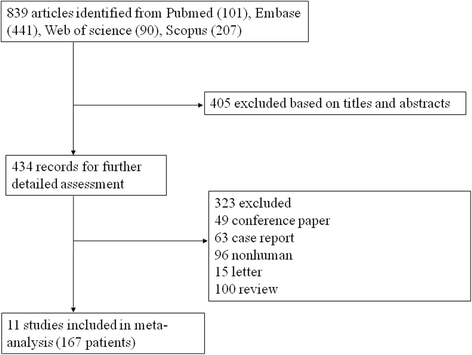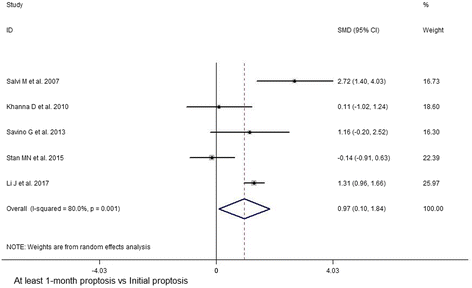Does rituximab improve clinical outcomes of patients with thyroid-associated ophthalmopathy? A systematic review and meta-analysis
- PMID: 29452583
- PMCID: PMC5816536
- DOI: 10.1186/s12886-018-0679-4
Does rituximab improve clinical outcomes of patients with thyroid-associated ophthalmopathy? A systematic review and meta-analysis
Abstract
Background: The current therapies of thyroid-associated ophthalmopathy (TAO) were still a challenging matter. In this study, we aimed to contrast the impact of before- after rituximab (RTX) therapy in the patients with TAO.
Methods: We searched the PubMed, EMBASE, and SCOPUS databases for articles published up to July 3, 2017. Fixed- or random-effects meta-analysis was used to provide pooled estimates of standard mean difference (SMD) both the primary outcome from clinical activity score (CAS), and secondary outcomes from thyrotropin receptor antibody (TRAb), proptosis, thyroid stimulating hormone (TSH), and interleukin-6 (IL-6) levels. In addition, the quality and each study was assessed using either the Newcastle Ottawa Scale (NOS) or the Cochrane Risk of Bias tool, and reliability of the meta-analytic result using the Grading of Recommendations Assessment, Development and Evaluation (GRADE).
Results: Of the 839 articles initially searched, 11 studies were finally eligible for inclusion. Subgroup analysis results showed that comparing with initial value, there was a decline in CAS at 1,3,6,12 month after RTX treatment, decreased TRAbs level at 6,12 month, proptosis improvement at least 1 month, unchanged IL-6 level at 6 month, decreased TSH level at 3 month but unchanged at 12 month. All included studies were classified as good quality.
Conclusions: The pooled data suggested that the preliminary effects of RTX treatment on TAO might be promising. However, more large-sample and high-quality studies targeting RTX use during this disease and long-term surveillance of prognosis are urgently needed.
Keywords: Drugs; Eye lids; Inflammation; Orbit; Vision.
Conflict of interest statement
Ethics approval and consent to participate
Not applicable.
Consent for publication
Not applicable.
Competing interests
The authors state that there is no competing interests regarding the publication of this paper.
Publisher’s Note
Springer Nature remains neutral with regard to jurisdictional claims in published maps and institutional affiliations.
Figures







References
-
- Smith TJ, Tsai CC, Shih MJ, Tsui S, Chen B, Han R, et al. Unique attributes of orbital fibroblasts and global alterations in IGF-1 receptor signaling could explain thyroid-associated Ophthalmopathy. Thyroid Official J Am Thyroid Assoc. 2008;18(9):983. doi: 10.1089/thy.2007.0404. - DOI - PMC - PubMed
-
- Bartalena L, Lai A, Compri E, Marcocci C, Tanda ML. Novel immunomodulating agents for graves orbitopathy. Ophthalmic Plast Reconstr Surg. 2008;24(4):251. - PubMed
Publication types
MeSH terms
Substances
Grants and funding
- 2015KYA113;2015ZB031/Supported by grants from the Medicine and Health Science Technology Project of Zhejiang Province (2015KYA113) the Scientific Research Foundation of Traditional Chinese Medicine of Zhejiang Province (2015ZB031)
- 81670888;2016YFC1100403/Supported by grants from the National Natural Science Foundation of China (81670888), National key research and development program (2016YFC1100403).
LinkOut - more resources
Full Text Sources
Other Literature Sources

